Do you have a specific gender in mind when it comes to choosing a dog breed? Typically most owners prefer one gender over the other due to personal preferences.

Regardless of the gender of Poodle you choose, you have to be on form when it comes to looking after them and taking care of both their health problems. So to help you prepare, today we’re going to highlight the female Poodle, and in particular, I’m going to highlight the topic of pregnancy.
Vet tip: the signs of pregnancy are usually only apparent in the last few weeks and when a dog is in the early stages, there are no signs.

Read our Smart Poodles - Smart Tricks eBook for only $2.99
Dive into a treasure trove of engaging tricks and tips designed specifically for your poodle!
It’s incredibly helpful for you as a dog owner to know, and it’s especially important if you’re looking to breed a female Poodle.
What Will You Learn? 👇
What are the signs of a pregnant Poodle?
Generally, a female Poodle can expect puppies as soon as they start their first heat at around 6–8 months. However, It is not advised as their body isn’t entirely developed then. Ideally, you will want to wait until at least two years old for a female Poodle to get pregnant. Regarding their pregnancy, there are several ways it can be diagnosed which I will uncover later. However, before that happens, you can look out for the common symptoms, which are:
Reduced activity
When a female Poodle is pregnant, she might be more tired and not have as much energy as usual. It’s also not uncommon for a female Poodle to sleep longer than usual or to take short, frequent naps. Therefore, it’s also essential that you pay attention to how tired she might get during walking or exercise.
Unusual behavior
Unusual behavior might occur in a female Poodle when they’re pregnant. It would help if you always looked for signs where a female might be working harder to command more attention and affection from you. She might be lingering more towards your side for company.
On the contrary, she could also be wanting to seek isolation and wish not to be bothered. They may also be more irritable or depressed than usual.
Disrupted appetite
One common sign of pregnancy in a female Poodle is changes to their appetite. At the beginning or the middle of her pregnancy, she might vomit sometimes or have a reduced appetite. There is also a chance she might eat more than expected and choose not to eat she usually enjoys. Look out for different behaviors regarding food, as their fluctuating hormones can affect their appetite.
Enlarged mammary glands
Usually, a female Poodle’s nipples will be small; however, as soon as they become pregnant, her nipples will grow even in the very early stages. You should lookout for a rounded shape as opposed to their regular flat shape.
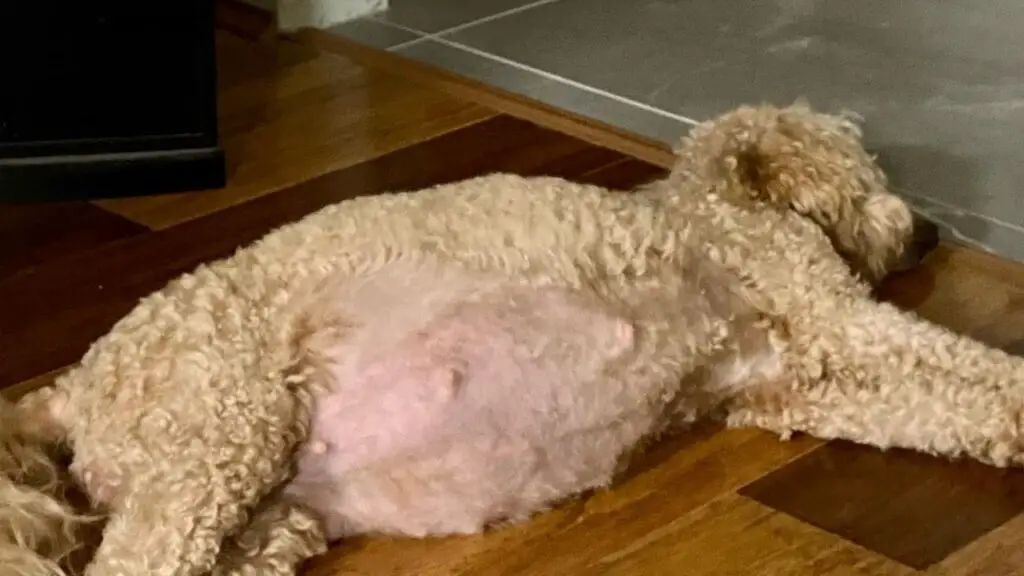
Another indicator of pregnancy is that they can become a dark red (darker than normal); this is often a sign of increased blood flow. Later on in her pregnancy, her nipples might leak discharge and milk.
Weight gain
Like humans, a dog’s abdomen can grow in size and is one of the key signs of a pregnant Poodle. Don’t depend on this sign, though; this usually happens a lot later into their pregnancy. But when this is noticeable, it’s time a female Poodle is taken to the vet.
Nesting
Towards the very end of pregnancy, you might find a female Poodle gathering her toys, materials, and other household items, making a nest. She might also start shredding her bedding when nesting. This symptom of pregnancy tends to happen in the final stages of a dog’s pregnancy.
What is a false pregnancy?
It’s always important to be alert and know when a female Poodle could be pregnant. But, in addition to this, you should also be cautious to know when they could experience pregnancy-related conditions. One, in particular, is a false pregnancy where they look pregnant when reality, they’re not. The scientific name for this is pseudo-pregnancy or pseudocyesis.
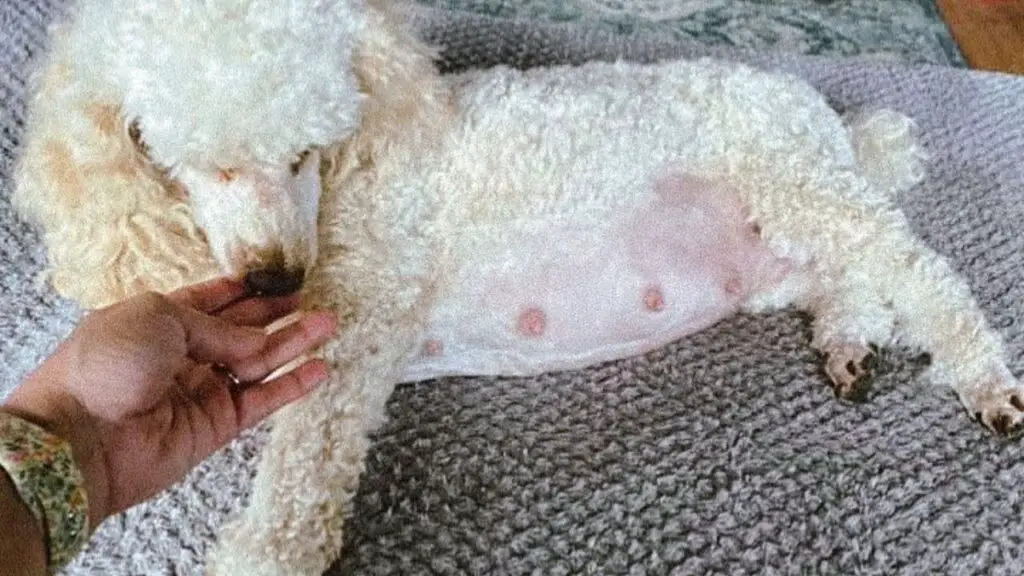
This is a condition that can occur in a female dog regardless of whether she’s been mated or not. It commonly occurs after their estrus cycle, and their ovaries produce hormones. The hormones they produce specifically help their uterus prepare for a potential fetus in pregnancy. These hormones can mimic a pregnant dog’s typical symptoms and cause their mammary glands to develop and false labor to occur. The hormonal changes have been explained scientifically.
Vet tip: A dog experiencing a phantom pregnancy can have all of the same signs as a real pregnancy, so we should never assume a dog is pregnant if they have not been scanned.
Generally, in a false pregnancy, a Poodle will experience the following:
- Nesting
- Mothering
- Restlessness
- Decreased interest
- Aggression
How is a false pregnancy treated?
If a false pregnancy is mild, their symptoms should subside in 14-21 days.
The majority of females need no treatment. Vets do sometimes give Galastop, which can reduce symptoms by inhibiting Prolactin. They never spay a female who is experiencing false pregnancy as it makes signs last longer. Rather, spay her once the false pregnancy has ended.
How long does Poodle pregnancy last?
On average, a Poodle pregnancy can last for 63 days after conception. However, it’s not a set period; the duration can vary a few days before or after. Part of the reason for this is that sperm can stay in a dog’s ovaries for several days, and it can take 48 hours for a female’s eggs to fertilize.
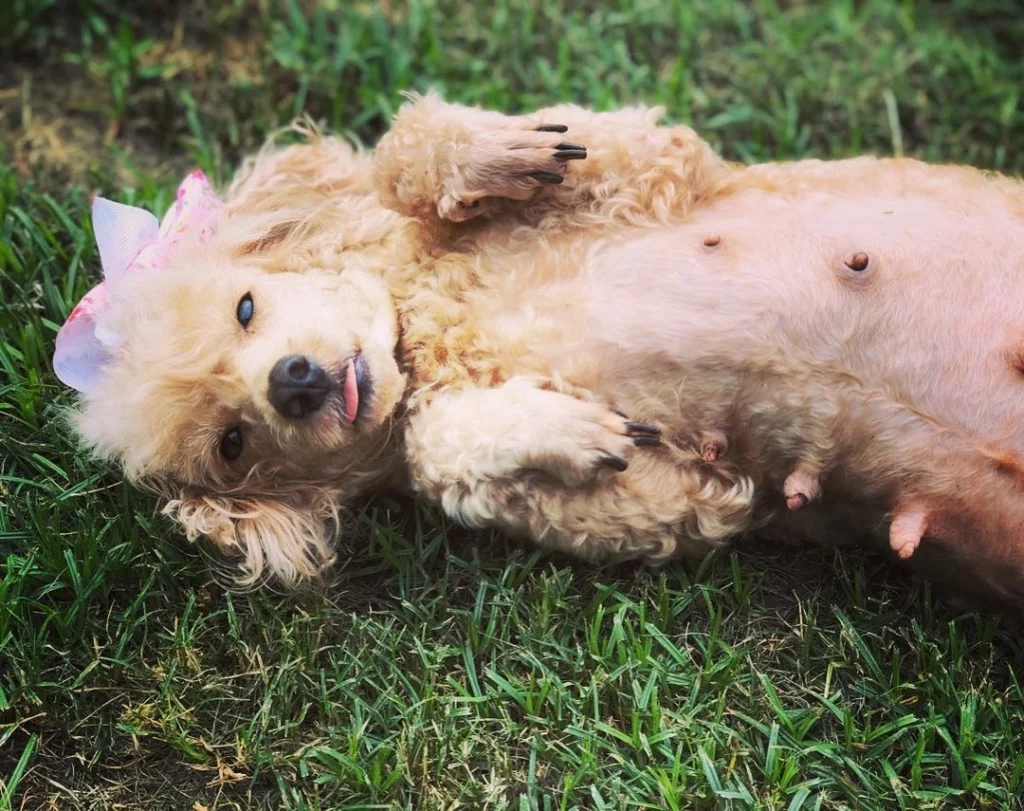
Due date calculator
How many puppies can a poodle have
By no means is a female the same across the three types of Poodle; their pregnancies can vary slightly.
- Standard Poodle: Compared to the other two types of Poodle, a Standard will generally have the most babies. Their average litter size is around 6-7 pups!
- Miniature Poodle: This Poodle typically has a litter of 5 puppies.
- Toy Poodle: On average, the litter size for the Toy breed is 3 puppies.
Care for pregnant Poodle
Like humans, a pregnant Poodle will experience a range of changes to their hormones, weight, and behavior. While we know this is happening to us, you have to pay extra attention to comfort your female Poodle as a dog owner. But first, before caring for them, you will want to make sure they’re pregnant. A vet will confirm their pregnancy through a range of tests such as the following:
- Blood test: A blood test can be conducted by day 30
- Ultrasound scan: From day 28 to 30, a vet might carry out an ultrasound scan to check for heartbeats.
- X-ray: After day 45, they might perform an x-ray to see how big the Poodle’s litter size is.
Exercise
Once confirmed, you should be more alert and empathetic towards a female’s wellbeing as a dog owner. You will want to take them for daily exercise to maintain their muscle mass but less intense than normal.
Nutrition
When pregnant, a Poodle must have a healthy metabolism so they can support themselves and their litter. Ideally, you will want to feed them puppy food full of nutrients and has more energy than adult-based dog food. The food should have 1,600 calories per lb and have around 22% protein. This should start as early as week 6 of their pregnancy and slowly replaced over time.
You will also want to slowly increase their portion sizes and not give them a large portion in one go. If you do, they might decline at first as they may be experiencing morning sickness. It would help if you slowly started increasing her portions as soon as she’s 5 weeks pregnant up until 9 weeks. At this age, she should be eating 25% more food than usual. Be careful not to overfeed your dog and measure her portions out evenly.
Medications
When a Poodle is pregnant, they might require certain medications to help with their lactating and to provide nutrients to their litter. In this situation, it’s important not to give your dog any medication without the advice of a veterinarian.
If you give your Poodle medications that your vet has not approved, it could cause them harm and result in birth defects in the puppies and, in the worse case, spontaneous abortion. In particular, you should avoid giving them calcium supplements as this can cause eclampsia which can be life-threatening.
Vet checks
It’s always a good idea to visit the vet to see if your dog is pregnant. Similarly, you should take your Poodle every month for a routine check-up. Plus, if she becomes ill while pregnant or gets parasites, they need to be addressed immediately.
Once pregnant, a Poodle should see the vet at seven weeks old, so they can check their general health and form a plan for their labor. If their labor is not a smooth process and a female Poodle has contractions for more than 30 minutes, you will have to call your vet. Then
Vet tip: Pregnant Poodles should be regularly de-wormed with Fenbendazole.
Preparing for birth Checklist
Birth can vary based on the type of Poodle you have. Most of the time, with a Standard Poodle, it’ll be natural, whereas Miniature and Toy Poodles might need a C section. Most of the time, Poodle births don’t have any complications.
However, if you have a pregnant Poodle, you should still be prepared, and it would be best if you did the following:
Isolated delivery area
Many Poodles will look for a natural area to give birth. Most of the time, the area will be where the female Poodle will feel safe and comfortable. You can prepare for this by making them quiet, dry, warm, and with no drafts. You should also make sure the area is private also.
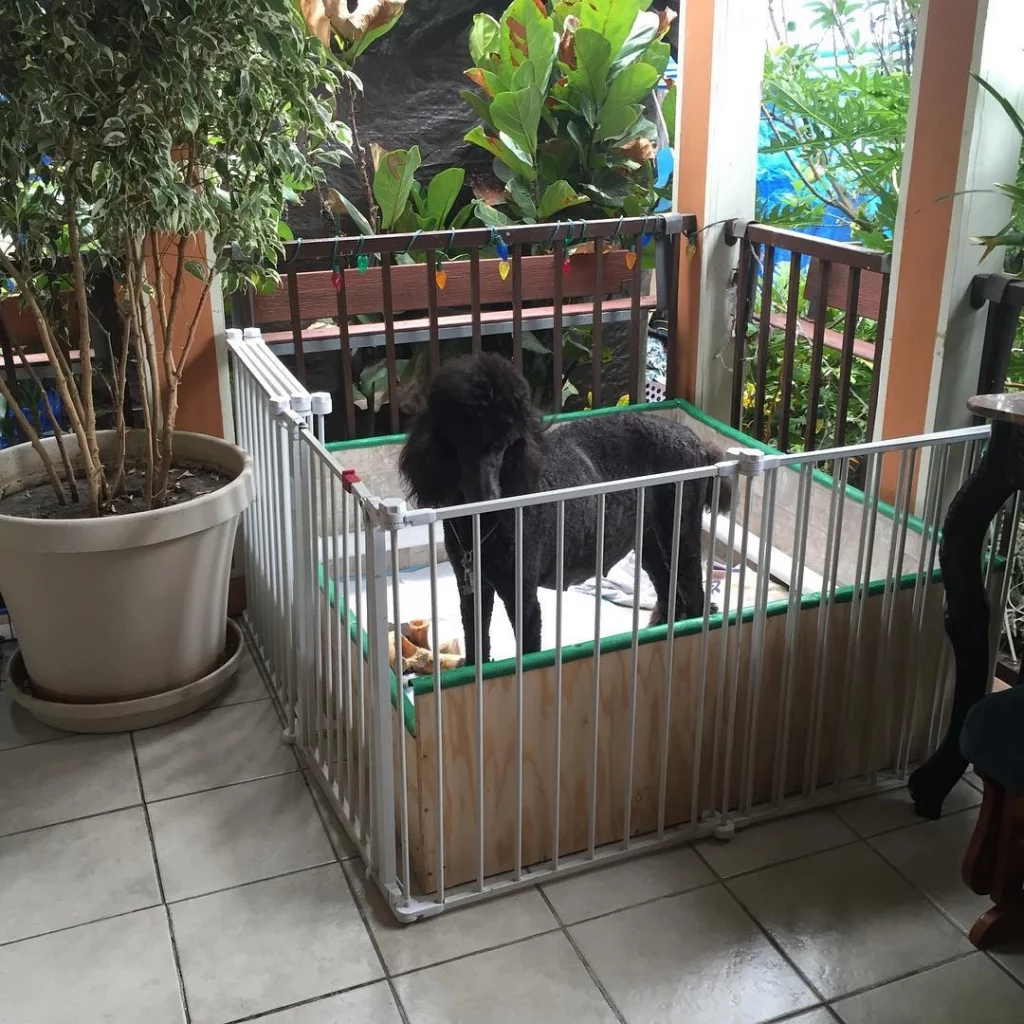
Whelping box
This is a cardboard box where a female Poodle can lie down stretched on her side. Ideally, you will want a box with 3 inches more room to let her litter lie on there. Make sure the sides are low and the box is roomy for dogs. The whelping box should be lined with newspaper and should be replaced once soiled. After your dog has given birth, you should add nonskid bath mats to stop puppies from sliding all over the box.
Vet contact details
It’s always a good idea to have your vet’s contact details on standby so you can get help when you need to. A vet will help you with the labor and determine how many puppies your dog might have.
Birthing Supplies
You will need to be prepared for the labor and have clean towels, sterile surgical gloves, and scissors to cut the umbilical cord. In addition to this, you should have dental floss to tie the cord and iodine to sterilize the area. You will also want to monitor the female Poodle’s temperature, so you should also have a thermometer to hand and a flashlight.
Record keeping supplies
When the delivery happens, you will want to keep accurate records using a pen, notebook, scales, measuring tape, and a camera. As soon as you notice a puppy being born, you should document their birth details like their time, weight, lengths, spots, health difficulties, and anything else. This will help you when you meet the vet later.
Possible problems
Sometimes when a Poodle is giving birth, they could encounter some problems, which are:
- Uterus abnormalities: This is when a Poodle’s uterus can become twisted or disrupted. When this happens, their uterine muscles might not contract properly, and a cesarean may need to happen.
- Difficulty to the birth canal: If a Poodle has damage to their pelvis, their birthing canal might become narrow, and they could have a small vulvar opening. In this situation, they may need surgery to deliver the puppies.
- Prolonged gestation: When gestation occurs over 70-72 days, they could give birth to oversized puppies that might not fit in their birth canal. Plus, if their placenta separates a little bit, they could suffer an early death.
- Maternal distress: If the female Poodle parent produces a green or copious vulval discharge, the litter is highly at risk.
- Excessive bleeding
- Excessive vomiting
- Extreme lethargy
- Straining when making bowel movements and having diarrhea
Post-pregnancy care
After 48 hours of the Poodle giving birth, a veterinarian should examine both the mother and the litter.
Cut hair
Your dog should have a sanitary cut around their mammary glands, legs, and other areas to ensure they’re clean. You can get this done professionally.
Check mammary glands
You will want to check for any signs of heat, redness, discharge, discoloration, inflammation, or pain. Her milk should be white and consistent; it should not discolor. If she does have any of these, it could be a sign of mastitis, and she will need to see a vet.
Take her and the litters temperature
You will want to take the temperature of all dogs for a few weeks. The normal temperature range should have between 94-97 degrees Fahrenheit. Once your dog has given birth, you should be aware that she might have a slightly high temperature for a few days. However, she has a higher temperature, stops eating, or becomes lazy and sees a vet after this.
Feed her
You will want to provide the mother with several meals throughout the day, all of the same sizes, but make sure they’re never large. Then, after she’s whelped, make sure she has something to drink and eat. She might eat more after birth which can be up to four times her intake than before she was pregnant.
Look out for eclampsia or milk fever
From the day the puppies have been born up until the first 4 weeks. The typical signs are restlessness, panting, muscle tremors, anxiety, and dilated pupils. If it’s not treated early, it can cause convulsions, collapse, limb rigidity, and death. Therefore if you see any of these signs, take your dog to a vet immediately.
How often should female poodles breed
As mentioned earlier, a Poodle can start breeding from 6 months, but it’s better they’re at least 2 years old. There’s a lot of skepticism, though, surrounding how often they should be bred. Some people suggest it’s ok to breed Poodles twice in a row then have a break.
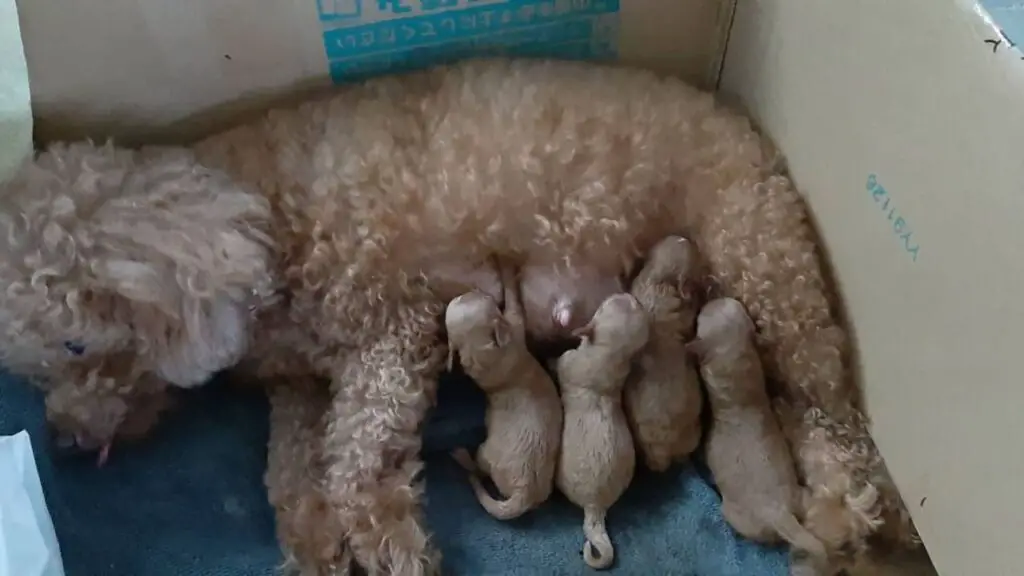
Whereas others advise, it’s ok to breed every other heat. On the contrary, if a female Poodle has had a cesarean, they should not be bred again. Plus, you should stop breeding a female after 5-6 years of age. If they have too much litter, they could be placed under extreme stress, and it could cause problems for their body.
Conclusion
Overall, if you have a female Poodle, you should prepare for their pregnancy. Before you breed them, you should always take them to a vet who can conduct a thorough examination to check to see if they’re ready for pregnancy or have recovered from their previous one. Make sure you regularly check in with your vet when they are pregnant, so they stay healthy.
What intrigues you about a Poodle pregnancy? Let us know below.
Marko is the founder and author at PoodleHQ, where he blends profound expertise with formal training in Animal Behavior and Canine Genetics. With multiple generations of poodles under his care, he’s a breed connoisseur, honored with the Canine Care Excellence Award and lauded by the International Pet Enthusiasts Association.

